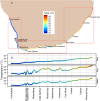A coastal seawater temperature dataset for biogeographical studies: large biases between in situ and remotely-sensed data sets around the Coast of South Africa
- PMID: 24312609
- PMCID: PMC3849325
- DOI: 10.1371/journal.pone.0081944
A coastal seawater temperature dataset for biogeographical studies: large biases between in situ and remotely-sensed data sets around the Coast of South Africa
Abstract
Gridded SST products developed particularly for offshore regions are increasingly being applied close to the coast for biogeographical applications. The purpose of this paper is to demonstrate the dangers of doing so through a comparison of reprocessed MODIS Terra and Pathfinder v5.2 SSTs, both at 4 km resolution, with instrumental in situ temperatures taken within 400 m from the coast. We report large biases of up to +6°C in places between satellite-derived and in situ climatological temperatures for 87 sites spanning the entire ca. 2 700 km of the South African coastline. Although biases are predominantly warm (i.e. the satellite SSTs being higher), smaller or even cold biases also appear in places, especially along the southern and western coasts of the country. We also demonstrate the presence of gradients in temperature biases along shore-normal transects - generally SSTs extracted close to the shore demonstrate a smaller bias with respect to the in situ temperatures. Contributing towards the magnitude of the biases are factors such as SST data source, proximity to the shore, the presence/absence of upwelling cells or coastal embayments. Despite the generally large biases, from a biogeographical perspective, species distribution retains a correlative relationship with underlying spatial patterns in SST, but in order to arrive at a causal understanding of the determinants of biogeographical patterns we suggest that in shallow, inshore marine habitats, temperature is best measured directly.
Conflict of interest statement
Figures








References
-
- Blanchette CA, Melissa Miner C, Raimondi PT, Lohse D, Heady KE, et al. (2008) Biogeographical patterns of rocky intertidal communities along the Pacific coast of North America. Journal of Biogeography 35: 1593–1607.
-
- Tittensor DP, Mora C, Jetz W, Lotze HK, Ricard D, et al. (2010) Global patterns and predictors of marine biodiversity across taxa. Nature 466: 1098–1101. - PubMed
-
- Couce E, Ridgwell A, Hendy EJ (2012) Environmental controls on the global distribution of shallow-water coral reefs. Journal of Biogeography 39: 1508–1523.
-
- van den Hoek C (1982) The distribution of benthic marine algae in relation to the temperature regulation of their life histories. Biological Journal of the Linnean Society 18: 81–144.
Publication types
MeSH terms
LinkOut - more resources
Full Text Sources
Other Literature Sources

